Bathroom Readers' Institute's Blog, page 32
November 7, 2018
Interesting Things Americans Voted On This Week

On Election Day, millions of Americans cast their votes for senators, members of congress, local officer holders…and some quirky and fascinating ballot measures and initiatives.

SOUTH POLL
In Florida, voters passed Amendment 4. Previously in the Sunshine State, people convicted of felonies lose their right to vote…forever. But with the passage of this measure, felons will get their suffrage privileges back after serving their sentence or completing their probation. This will add as many as 1.5 million voters to the rolls. (Not part of that group: those convicted of murder.)
NO DOGS ALLOWED
Also in Florida, voters approved Amendment 13, which will gradually ban a popular spectator sport: dog racing. By 2020, it will be illegal statewide to race greyhounds or place bets on racing greyhounds.
SPRING FORWARD AND STAY THERE
The times they are a-changin’ in California…or rather, not at all. Proposition 7 passed with more than 60 percent of voters approving. It will allow the state to eliminate the biannual time changes, or “spring forward, fall back” associated with Daylight Saving Time. If it goes into effect, California will stay on the same time schedule year-round.
THE JURY IS IN
In Louisiana, voters said yes to Amendment 2. It removes a law on the books that allowed juries in the state to return non-unanimous verdicts. In other words, juries there could convict a criminal with, say, a 7-5 vote rather than 12-0. That makes Oregon the only state in the nation to allow non-unanimous jury rulings.
NO SORT-OF-SMOKING ALLOWED
Another one from Florida, and this one is a response to one of the biggest fads of the last few years. Millions of people no longer smoke but “vape,” using electronic cigarettes to inhale nicotine-laced vapor that some claim is healthier than breathing in smoke. Nevertheless, Amendment 9 passed, banning indoor vaping in Florida.
The post Interesting Things Americans Voted On This Week appeared first on Trivia Books and Facts | Uncle John's Bathroom Reader.
November 6, 2018
Crazy Little Things About Queen
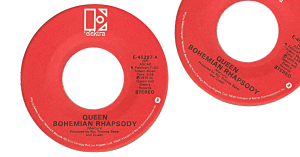
Bohemian Rhapsody, a film about the life of rock legend Freddie Mercury, and his band, Queen, hits theaters soon. Before you see that eye-opener about the group’s impact on music, check out these unbelievable but true facts about Mercury and Queen.
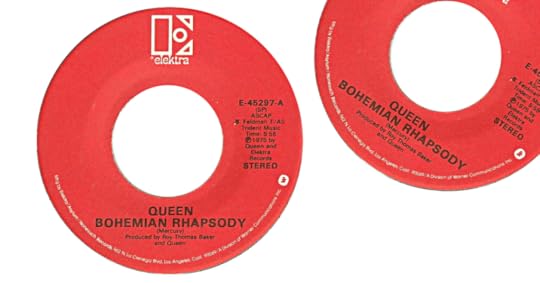
Naked bicycling
In 1978, Queen released the hit single “Bicycle Race” and filmed a video for the song at Wimbledon Greyhound Stadium in London. The main image of that video: 65 female models, hired for the day, riding bicycles around the stadium’s track, in the nude. The biggest expense for Queen, apart from renting the arena, was all those bikes. A bike company agreed to loan out 65 two-wheelers, but when it found out they’d be used by naked people, it made Queen purchase and provide their own bicycle seats.
Bohemian Rhapsody
On Halloween 1975, Queen released what would go on to become its most famous and enduring song: the operatic “Bohemian Rhapsody.” Mercury helped layer more than 180 different vocal tracks onto the recording. When it was finally done(after many arduous days of recording), the band’s guitarist, Brian May held up the master tape to a light and discovered that it was so worn out that it had grown transparent.
Wayne’s World
“Bohemian Rhapsody” topped the charts in the U.K. and reached the top 10 in the U.S., but it almost inexplicably became a bigger hit in 1992. It was the centerpiece of a scene in the hit comedy Wayne’s World, in which metalheads Wayne (Mike Myers) and Garth (Dana Carvey) headbang to the song in a car. It hit #2 in the U.S. that time, and to think that it almost didn’t make it into the movie. Myers co-wrote the movie, and was so devoted to having “Bohemian Rhapsody” in the scene he wanted it in, that he threatened to quit the movie if producers had their way, and replaced the tune with a Guns n’ Roses song.
Will you do the Fandango?
Still, it’s a weird, cryptic song with lines like “Bismillah, no! We will not let you go!” and “Scaramouch, Scaramouch, will you do the Fandango?” Not until 2000 (years after Mercury’s death) was the song explained. It’s about a murderer who sells his soul to the devil.
Memorable bass line
Another of Queen’s most songs is “Under Pressure,” its 1981 collaboration with David Bowie. It’s driven by a simple but memorable bass line courtesy of the group’s bassist, John Deacon. He was messing around on his instrument in the studio one day and came up with it, but then after the band went out for pizza and returned…he’d forgotten the riff entirely. A few hours of experimentation later, and Queen drummer Roger Taylor pieced the riff back together from memory.
Cat lover
Freddie Mercury loved cats. He owned as many as 10 in the mid-‘80s, to which he dedicated his first solo album, Mr. Bad Guy (1985). In the liner notes he called out “my cat Jerry, also Tom, Oscar, and Tiffany, and all the cat lovers across the universe.”
The post Crazy Little Things About Queen appeared first on Trivia Books and Facts | Uncle John's Bathroom Reader.
November 5, 2018
Giving It the Old College Try

College football is one of the oldest sports in the country, with east coast teams squaring off on the gridiron in the late 1800s. Here are some of the oldest players to ever play the game — as in they weren’t exactly of the “traditional” college age.
Joe Thomas, Sr.
The oldest guy to ever play in Division I football — the highest level, for big and major schools — was 55-year-old Joe Thomas, Sr. At the time, his son, Joe Thomas, Jr., was playing at linebacker for the Green Bay Packers. But dad was a running back who hung around with the squad at the University of South Carolina long enough that in 2016, he got in the game. He rushed for three yards in the first quarter of a game.
Tom Thompson
One of the oldest guy to ever play any kind of college football in the United States was a kicker named Tom Thompson. Back in the early ‘60s, he was the backup kicker on his high school team. In November 2009, he resumed the position for Division III school Austin College. At age 61, Thompson kicked an extra point during team’s 44 to 10 loss to Trinity.
Alan Moore
Thompson shares his record with Alan Moore, a junior college kicker whose education was interrupted in 1969 by service in the Vietnam War. In 2011, after getting laid off, the then-61-year-old joined the squad of Faulkner University in Alabama.
Donovan Tate
In 2017, Donovan Tate was on the University of Arizona’s roster as a backup quarterback. His name might sound familiar to hardcore sports fans — way back in 2009, he was the overall number-three pick in the Major League Baseball draft. His career ended after a short stint in the minors, which included a 50-game suspension for violating a substance use policy. A year after he played his last minor league game in 2016, he went back to school…and joined the football team at age 26.
The post Giving It the Old College Try appeared first on Trivia Books and Facts | Uncle John's Bathroom Reader.
November 2, 2018
A World Series For the Record Books

The 2018 “Fall Classic” is all over. The Boston Red Sox defeated the Los Angeles Dodgers in five games to win its ninth overall World Series. It was a bit of a nutty postseason, and here are some of the records that were set since the end of the regular season.
Longest game ever
The ridiculously long Game 3 of the 2018 World Series set a number of endurance records. It was the longest World Series game in baseball history, as well as the longest playoff game of any kind. It went on for seven hours and 20 minutes East Coast viewers had to stay up until 3 a.m. to see Max Muncy hit a dramatic, game-winning home run for the Dodgers in the bottom of the 18th inning.
Most innings ever
It’s also the longest World Series game in not just time, but innings played, at 18. The previous record of 14 (set in 1916 and tied in 2005 and 2015) was shattered.
How long was it?
That game was so long. (HOW LONG WAS IT?) It was so long that its running time is more than the 1939 World Series in its entirety. That year, the New York Yankees swept the Cincinnati Reds in four games with utter efficiency.
How many players?
A total of 46 combined players (including 18 pitchers) took part in that Game 3. That beat the previous record of 43. The only roster members who didn’t play for either team: Game 4’s probably pitchers for both squads.
Strike-out record
Altogether in Game 3, players on both teams struck out a total of 34 times. That’s a one-game record, too.
No hits
Boston’s Xander Bogaerts set a record for World Series futility. Despite eight trips to the plate, he didn’t get a single hit.
When did the teams last play together in the World Series?
Despite being two of the oldest franchises in baseball (and in all of sports), the Red Sox and Dodgers have only played each other in the World Series once before: in 1916. That makes for the longest span between two teams meeting, and that first time was so long ago that the Los Angeles Dodgers weren’t based in Los Angeles or even called the Dodgers — they were the Brooklyn Robins at the time. And on the mound for Boston: young pitcher Babe Ruth.
Lots of records for Boston’s manager
Boston manager Alex Cora (a former Dodgers player) led the team to victory. Not only is he one of the few rookie managers to ever go all the way to the World Series, but at age 43, he’s one of the youngest. Cora is a native of Puerto Rico, and his trip to the championship made him the first Puerto Rican manager to guide a team to the Series, as well as to win one.
The post A World Series For the Record Books appeared first on Trivia Books and Facts | Uncle John's Bathroom Reader.
November 1, 2018
Classroom Origins

Close your eyes and think back on your school days. Picture that chalkboard and the hand-cranked pencil sharpener, and that soft pink eraser in your desk. Here’s where all that stuff came from. (This article was first published in our 31st annual edition, Uncle John’s Actual and Factual Bathroom Reader .)
Pink Erasers
The Faber-Castell Company had been making pencils in Bavaria since the 1760s. Fourth-generation operator John Eberhard Faber took over in the 1850s and moved the company to Greenpoint, Brooklyn, where he opened America’s first pencil factory in 1861. Soon after, the company secured a contract to make a line of pencils to be sold at Woolworth department stores. Marketed under the name Pearl Pencil, they were topped with erasers that combined rubber and pink pumice—volcanic ash imported from Italy. The erasers worked so well that Faber started making stand-alone erasers (for all those mistake-prone kids who wore out their pencil erasers before they wore out their pencils).
Pencil Sharpener
What’s the old-fashioned way to sharpen a pencil? Whittling away at the tip with a knife until it was fine. That was time-consuming, inexact, and, for children, potentially dangerous. In 1828 a French mathematician named Bernard Lassimone received a patent for the taille-crayon—literally, “pencil cutter.” A system of tiny metal files was ensconced in a block of wood, a pencil was inserted, and, as the pencil was slowly turned, the files whittled away at the pencil tip’s sides. It was safer than a knife, but apparently not much faster or cleaner. Inventors in Europe and North America kept trying to improve on Lassimone’s design until the 1840s when French inventor Therry des Estwaux came up with the idea to make the “pencil insertion chamber”conical and lined with blades—that way, when a pencil went in and was turned, every side was shaved down equally and all at the same time.
Blackboard
There’s archaeological evidence that students used something akin to individual blackboards as far back as ancient Babylonia. They didn’t have paper and pencils (or pens), so they took notes and wrote lessons on smooth clay tablets with a clay stylus. They’d erase the tablets by wiping them down with water, or writing could be made permanent with a simple bake in a kiln. Over the centuries and around the world, by the 18th century, clay tablets had evolved into “slates” in the West—tablet-sized writing surfaces made out of either actual slate or wood painted with slick, washable paint. Pro: They were cheap and reusable. Con: Teachers had no way to demonstrate a group lesson—they had to go from student to student to show them, for example, a math problem.
In 1801 James Pillans, the headmaster of Old High School in Edinburgh, Scotland, came up with a solution: He hung a very large piece of slate on the wall at the front of his classroom and wrote on it with a piece of chalk. The idea spread through Europe and then to the United States, where black slate was especially cheap and plentiful thanks to slate mining operations across the Eastern seaboard. The blackboard remained mostly unchanged until the 1960s, when a green-colored board—a steel plate coated with green porcelain enamel paint—was introduced. The new green boards were easier to read than blackboards from the back of a classroom, and chalk dust erased more efficiently. (But they were still called blackboards.)
Blackboard Eraser
All those blackboards had to be wiped clean with something. At one time, teachers used an old damp rag. But there were some downsides to that method: 1) it took the board a long time to dry, 2) it was messy, and 3) it left behind a lot of chalk dust. In the early 1860s, John Hammett, the owner of a Rhode Island school supply store that sold mostly slates and chalk, figured out a better way. A piece of cheap, dry felt was much more efficient than a wet rag. He commissioned an easy-to-handle, felt-wrapped item, and the first eraser that his team came up with is pretty much unchanged today.
An Apple for the Teacher
The origin of this custom is not definitively known, but here’s one reasonable theory: As settlers laid down roots in the American Midwest in mid-1800s, they opened small, one-room schoolhouses to teach the children. It was the responsibility of the community to find a teacher—almost always a young unmarried woman. And because they couldn’t afford to pay much, if anything at all, the community took care of the teacher’s basic needs as best they could. Someone might donate a home, for example, while parents of other kids might help keep her fed. An apple for a teacher was an outgrowth of that—a sweet treat for a job well done (in lieu of salary). But why apples and not, say, peaches or corn? Kids may well have brought those, too, later in the year. Apples may be the iconic gift for teachers because the beginning of the school year coincides with peak apple season in September.
The post Classroom Origins appeared first on Trivia Books and Facts | Uncle John's Bathroom Reader.
October 30, 2018
Forgotten Halloween Traditions
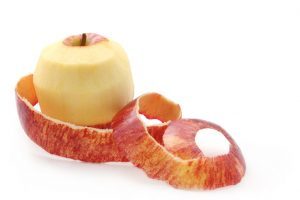
How are you celebrating All Hallow’s Eve? Trick-or-treating, taking someone trick-or-treating, or bobbing for apples? You probably won’t get up to some of these old-fashioned things.
Apple Wedding
A Scottish tradition that spread to New England, and rarely done in either spot these days: apple peeling. Revelers would engage in a little game where the object was to use a knife to peel an apple’s skin all at once without breaking it, and then throw the skin over your shoulder. Then, you look at the apple skin, and the letter that it most resembles is said to be the first letter of the name of your future spouse.
The Root (Vegetable) of a Tradition
We carve faces into pumpkins around Halloween because that plant is abundant in the Americas. The tradition was born out of one in Western Europe, where people made scary faces out of turnips and beets.
Block Party
In colonial America, people would get together with their neighbors on Halloween to celebrate the harvest. They’d have “play parties,” where the events including dancing, singing, sharing memories about dead loved ones, and trying to predict each other’s future.
This One is Nuts
As the song goes, Christmas is the time for “chestnuts roasting on an open fire.” But Halloween was once the time for roasting hazelnuts over a flame…for important reasons. This Halloween tradition, which dates to the ancient Celts, involved unmarried women assigning a hazelnut to represent each of their suitors. Then they’d toss them into a fire. The one that burned (rather than popped) meant the guy the nut represented would one day marry the lady.
Stick to it
A kind of vertical variation on bobbing for apples, this 20th century Halloween party game required you to hang a broomstick from the ceiling, so it ran parallel with the floor. One end, you tied an apple, and on the other, a bag of flour. Then you spin the stick around and invite your party guests to stick their head in there to try to bite the apple…or get a face full of flour (or stick).
This One Has Got Soul
Trick-or-Treating comes in part from a 19th century tradition called “souling,” where kids would go door-to-door and offer prayers for the residents therein. In exchange and in thanks, they received small spice cakes called “soul cakes.”
The post Forgotten Halloween Traditions appeared first on Trivia Books and Facts | Uncle John's Bathroom Reader.
What’s Really In a Witch’s Potion?
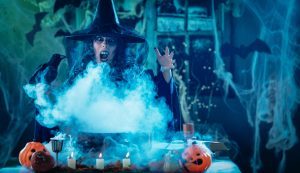
In countless movies, TV shows, and plays — particularly Shakespeare’s spooky Macbeth — witches are depicted stirring up a cauldron full of a nasty and powerful potion that will make others do who knows what. All the ingredients inevitably come with creepy, witchy-type names…but there’s really not all that weird. Here’s what (fictional) witches are really using when they’re brewing up trouble.
Eye of newt
A newt is a kind of toad, but witches in movies aren’t really supposed to kill a frog-like creature just to gouge out of one its eyes. Rather, this is an ancient term for mustard seed, which is far less frightening and could even lend the potion a spicy kick. (But still, you shouldn’t eat or drink that potion, because some of these ingredients could make you very sick…or worse.)
Toe of frog
Another “common” potion ingredient, it’s similar to eye of newt in that it doesn’t really derive from a victimized, pint-sized reptile. Toe of frog is a medieval name for the ordinary buttercup flower.
Wool of bat
First of all, good luck catching a bat, those red-eyed, nocturnal rodents of the skies, let alone getting its wool. That’s because bat’s don’t have wool (they aren’t sheep, after all), they have fur. But technically, wool of bat refers to the leaves of a plant far more associated with Christmas than Halloween: holly.
Tongue of dog
Houndstongue is a velvety-leaved, red-flowering weed found all over Europe and North America. It gets its name because touching the leaves feels at least vaguely like when a dog licks one’s skin. Trade out “hound” for “dog,” and switch the order of two parts of its compound title and houndstongue become “tongue of dog.” The witches are using these weeds, not a pooch’s wagging tongue.
Blind-worm
This isn’t a cute name for a long and bulbous herb or flower — it’s the name of a small snake that people in medieval times thought was venomous. (It’s not, but it’s still kind of creepy.)
The post What’s Really In a Witch’s Potion? appeared first on Trivia Books and Facts | Uncle John's Bathroom Reader.
October 29, 2018
Some Random and Spooktacular Facts About Classic Halloween Movies
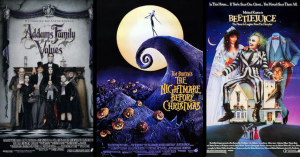
After you head in after the trick-or-treating and costume parties are over, will you watch one of these fall classics?
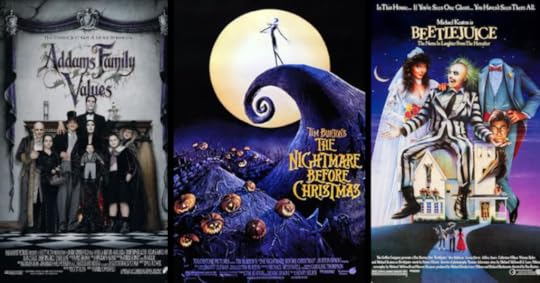
Addams Family Values
In Charles Addams original New Yorker cartoons, the family had no names, so they were created for the Addams Family TV show in the ‘60s. For the dim son, Addams suggested either Pugsley or Pubert. Producers chose Pugsley because Pubert sounded vaguely dirty. So, when the plot of the second Addams Family movie in 1993 called for Morticia to give birth to a new baby, screenwriters used the name Pubert as a nod to the franchise’s history.
A Nightmare on Elm Street
Johnny Depp’s first movie role came in this film as the teenager Freddy Krueger terrorizes. Depp got the role when he accompanied his friend, Jackie Earle Haley to his audition. Director Wes Craven selected Depp, and didn’t cast Haley…although Haley would go on to play Freddy Krueger in the 2010 remake of the movie.
Beetlejuice
The film about the “ghost with the most,” portrayed by Michael Keaton, who helps a recently departed couple try to get the humans who bought their house to leave, almost had a different title. Producers almost called it the boring House Ghosts. Director Tim Burton hated that, but thought he’d game his way into getting the title he wanted (Beetlejuice) by suggesting an even worse title: Scared Sheetless. But then the execs like that title even better…before realizing Beetlejuice was the way to go.
The Nightmare Before Christmas
Director Tim Burton adored horror movie icon Vincent Price, and cast him in what would be some the legend’s final two films. He portrays Edward Scissorhands’s “father” in Edward Scissorhands, and he recorded his lines as Santa Claus in Burton’s stop-motion holiday-mashup movie, The Nightmare Before Christmas, just before his death in 1993. However, Price’s voice began to crack and fail after the death of his wife in 1991, and his tracks were unusable. (Edward Ivory re-recorded the part.)
Hocus Pocus
Early ‘90s teen star Omri Katz played the lead role of Max, a kid who accidentally wakes the Sanderson Sisters, actual Salem, Massachusetts ghosts from the 1600s. It’s Katz’s biggest role, but he was producers’ second choice. Max was first offered to then-Growing Pains star Leonardo DiCaprio, who passed on Hocus Pocus to make What’s Eating Gilbert Grape? instead. (Good move: He got an Oscar nomination for his work.)
The post Some Random and Spooktacular Facts About Classic Halloween Movies appeared first on Trivia Books and Facts | Uncle John's Bathroom Reader.
October 26, 2018
When Canada Tried to Join America
If there’s ever a 51st state in the United States, it’ll most likely be Puerto Rico or the District of Columbia. But if these very small political movements had had their way, we’d already have more states: former Canadian provinces.
All of Western Canada
The Unionest (“union” + “best”) formed in 1980 by former members of the Progressive Conservative Party of Saskatchewan as a response to a number of small western Canadian separatists groups at the time who were opposed to the left-wing federal government’s policies. Those groups often called for the four westernmost Canadian provinces — British Columbia, Alberta, Saskatchewan, and Manitoba — to form a new country. The Unionest Party had another idea — have those four provinces join the United States, which, at the time, was governed by the conservative president Ronald Reagan. The Unionests managed to get two members (its founders) into the Saskatchewan legislative assembly (because they left their old party), but they couldn’t garner much support. The “let’s join America” movement quickly died out.
All of Maritime Canada
In 1987, Canadian prime minister Brian Mulroney, and the premiers (they’re like governors) of all 10 of Canada’s provinces, proposed the Meech Lake Accord, a series of constitutional amendments. Created in large part to assuage the more independently-minded government of Quebec, it fell apart over time due to objections from around the country (support waned as premiers changed), and jumpstarted Quebec’s growing drive for independence. However, Nova Scotia premier John Buchanan, said that if the Accord failed, it would so destabilize the country that he said his province, and the other small, Atlantic provinces of New Brunswick, Prince Edward Island, and Newfound and Labrador, would have no choice but to join up with the United States. (Everything worked out in the end.)
Quebec
Quebec is the most French-influenced (and proudly French-speaking) Canadian province, and also the one that’s tried and failed several times to form its own, independent nation. Parallel to that plan has been a quieter, less famous movement to link Quebec to the United States. In 1989 elections, the Quebec-based Parti 51 fielded candidates…and won just 0.11 percent of the vote (the Communists got more), and that was the end of that. However, in 2016, a Quebec lawyer named Hans Mercier revived Parti 51, on the notion that the U.S. is a very welcoming place, and would accept a brand-new state with open arms. (No developments yet, but we’ll let you know when Quebec becomes the newest state.)
The post When Canada Tried to Join America appeared first on Trivia Books and Facts | Uncle John's Bathroom Reader.
October 25, 2018
Name That Soup

Ever wonder who put the “strone” in “minestrone”? The “owder” in “chowder”? The “ho” in “pho”? (Careful, there, soup boy! This is a family soup book!) Then sit thee down at the Table of Label—and read all about the name origins of several well-known soups. . (This article was first published in our 31st annual edition, Uncle John’s Actual and Factual Bathroom Reader.)
MINESTRONE
Minestrone originated in simple vegetable and bean-based soups and stews made by the people who inhabited the area around Rome more than 2,000 years ago. Those early soups evolved as new ingredients became available—notably tomatoes, which were introduced into Europe from South America during the Age of Exploration— eventually becoming the thick vegetable, bean, and pasta (and sometimes rice) soup we know today. The name “minestrone” derives from minestra, the Italian word for “soup.” The -one ending makes it mean something along the lines of “big soup.” The word entered the English language in the 1870s. (Note: minestra is “soup,” but it literally means “that which is served,” from the Italian verb minestrare, meaning “to serve,” which in turn comes from the Latin minister, meaning “servant.” Which explains why “minestrone” has the same etymological origins as the word “minister.”)
BORSCHT
Borscht is the name used for a wide variety of sour soups of eastern European/Slavic origin. There are many varieties, including red and white borschts, some of them served hot, but the best known is the red, beet-based, served-cold borscht whose origins are Ukrainian. The English word “borscht” dates to the 1880s, and comes from the Yiddish name for the soup. That, in turn, is derived from borshch, the Russian name for the common hogweed plant (also known as “cow parsnip”). The pickled flowers, stems, and leaves of the common hogweed were once the basis of this soup, which was how it got its sour taste.
PHO
Pho, pronounced “fuh,” is a brothy Vietnamese soup made with rice noodles, herbs, and usually with thin slices of beef or chicken. It is hugely popular in Vietnam, and is sold by street vendors and in restaurants nationwide. Most common time to eat pho: breakfast, although it is also eaten for lunch or dinner. And it’s a relatively young dish, believed to have originated in the early 20th century, in the country’s north, not far from Hanoi. There are two main theories as to the origin of the name of this soup—and neither are Vietnamese. The first is that “pho” was derived from the French word feu, meaning “fire,” or more accurately from pot de feu, literally “pot on the fire,” the name of a thick French beef stew. Vietnam was a French colony at the time pho was developed, and because the French are credited with making beef popular in the country, this is the version most etymologists support. The second theory is that “pho” was derived from the Cantonese word phan, meaning “noodles.” Either way, it came to English as the name of this tasty soup in 1931.
BISQUE
Bisque is a smooth and creamy crustacean-based soup of French origin. (It is most famously made from lobster, but can also be made from crab, crayfish, or shrimp.) The name “bisque” was probably derived from the name of the region where the soup was first made: the area around the Bay of Biscay, in southwestern France and northern Spain. Some historians believe the word came from bis cuites , meaning “twice cooked,” referring to the fact that the crustaceans involved are first cooked separately, then again with the other ingredients—butter, flour, carrots, celery, onion, wine, and brandy. If this is true, then bisque has the same origin as biscuit , which is known to have been named for its original two-part cooking method. Still another possible origin of the term: “bisque” was derived from bisco , a word in the French Provençal language meaning “small, beveled pieces,” referring to the crustacean pieces in thesoup. Wherever this name came from, it first arrived in English in around the 1640s. (Bonus fact: The original French use of “bisque” referred to soup made from the meat game birds. It only got the crabby meaning in the 17th century.)
The post appeared first on Trivia Books and Facts | Uncle John's Bathroom Reader.










